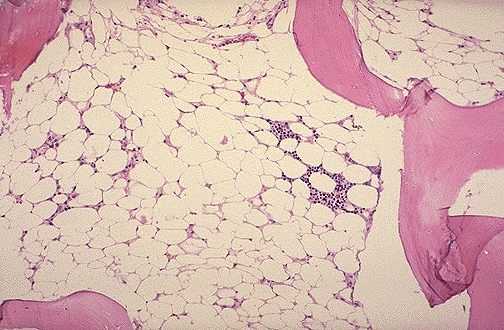Aplastic anemia pathophysiology: Difference between revisions
Nazia Fuad (talk | contribs) |
Nazia Fuad (talk | contribs) |
||
| Line 60: | Line 60: | ||
== Genetics == | == Genetics == | ||
Genes involved in the pathogenesis of aplastic anemia include: | |||
* HLA-DR15 | |||
* CD4+ CD25+ FOXP3+ regulatory T cells | |||
* STAT3 | |||
Genes involved in the pathogenesis of | * TERT | ||
* | * TERC | ||
* | |||
* | |||
* | |||
* | |||
== Associated Conditions == | == Associated Conditions == | ||
* Fanconi's anemia | |||
* PNH Paroxysmal Nocturnal Hemoglobinuria | |||
== Gross Pathology == | == Gross Pathology == | ||
Aplastic anemia does not exhibit any gross pathology | |||
== Microscopic Pathology == | == Microscopic Pathology == | ||
In aplastic anemia bone marrow microscopy reveals hypo and even acellularity, adipose tissue and pale stroma. | |||
{| align="right" | {| align="right" | ||
|[[File:Aplasticanemia.jpg |400px|thumb|right|Image yellow fat ladden marrow https://www.wikidoc.org/index.php/File:Aplasticanemia.jpg source:By Wmheric [CC BY-SA 3.0 (https://creativecommons.org/licenses/by-sa/3.0)] [Public domain], from Wikimedia Commons]]] | |[[File:Aplasticanemia.jpg |400px|thumb|right|Image yellow fat ladden marrow https://www.wikidoc.org/index.php/File:Aplasticanemia.jpg source:By Wmheric [CC BY-SA 3.0 (https://creativecommons.org/licenses/by-sa/3.0)] [Public domain], from Wikimedia Commons]]] | ||
Revision as of 19:34, 15 August 2018
|
Aplastic anemia Microchapters |
|
Diagnosis |
|---|
|
Treatment |
|
Case Studies |
|
Aplastic anemia pathophysiology On the Web |
|
American Roentgen Ray Society Images of Aplastic anemia pathophysiology |
|
Risk calculators and risk factors for Aplastic anemia pathophysiology |
Editor-In-Chief: C. Michael Gibson, M.S., M.D. [1]; Associate Editor(s)-In-Chief: Priyamvada Singh, M.D. [2] Nazia Fuad M.D.
Please help WikiDoc by adding content here. It's easy! Click here to learn about editing.
Overview
Pathophysiology
Physiology
The normal physiology of bone marrow can be understood as follows:[1]
- Bone marrow is a spongy tissue, found within the spongy or cancellous portions of bones
- It is higly vascularized and richly innervated
- Bone marrow is the primary site of hematopoiesis
- It is composed of hematopoietic cells, marrow adipose tissue, and stromal cells.
- Hematopoietic stem cells (HSC) in the bone marrow are the source of all mature cells in the peripheral blood and tissues and are multipotent.
- HSC are recognized and isolated according to their immunophenotype.
- HSCs make a small population within the CD34+/CD38 fraction of bone marrow cells.
- The hematopoiesis is controlled by a various regulatory mechanisms, including growth factors.
- The normal bone marrow structure can be damaged or displaced by aplastic anemia, malignancies or infections.
- This leads to decrease production of blood cells and blood platelets.
.
Pathogenesis
The most defenitive feature in pathophysiology of aplastic anemia is loss of hematopoietic stem cells.[2]
Pathophysiologic mechanisms that result in loss of HSCs and cause aplastic anemia include:
Hematopoietic Failure
- CD34 cells are almost absent aplastic anemia.
- Progenitor cells capable of forming erythroid, myeloid, and megakaryocytic are greatly reduced.
- The primitive hematopoietic cells which are closely related to stem cells are consistently deficient.
- The white blood cells in aplastic anemia have short telomeres.
- Telomeres are repeats at the end of eukaryotic chromosome and are essential for chromosome protection and complete DNA replication.
Immune-mediated T-cell destruction of marrow
- Drugs, chemicals, viruses, and different kind of mutations change the immunologic appearance of HSCs resulting in autoimmune destruction of marrow cells.
- In patients with acquired aplastic anemia, lymphocytes are responsible for the destruction of the hematopoietic cells.
- These T cells produces an inhibitory factor, interferon-�., tumor necrosis factor, and interleukin-2, resulting in hematopoitic cell death by apoptosis.
- CD4+CD25+FOXP3+ regulatory T cells are deficient in these patients, similar to what is seen in other autoimmune conditions.
- Deficiency of these regulatory T cells result in increase of T-bet protein levels in T cells, increased interferon (IFN)-γ,2 and stem cell destruction.
- Increased immune response, including tumor necrosis factor -α, IFNγ, and interleukin-6, are also very common in AA patients.
Clonal Evolution
- AA may develop gradually into other hematologic disorder which include
- Paroxysmal nocturnal hemoglobinuria [PNH]
- Myelodysplastic syndromes [MDS]
- Acute myeloid leukemia [AML]).
- Clonal evolution in AA can occur due to mutations or cytogenetic abnormalities.
- The genes that are commonly found to be mutated are
- DMNT3A
- ASXL1
- BCOR
- BCORL1
- PIGA
Genetics
Genes involved in the pathogenesis of aplastic anemia include:
- HLA-DR15
- CD4+ CD25+ FOXP3+ regulatory T cells
- STAT3
- TERT
- TERC
Associated Conditions
- Fanconi's anemia
- PNH Paroxysmal Nocturnal Hemoglobinuria
Gross Pathology
Aplastic anemia does not exhibit any gross pathology
Microscopic Pathology
In aplastic anemia bone marrow microscopy reveals hypo and even acellularity, adipose tissue and pale stroma.
 |